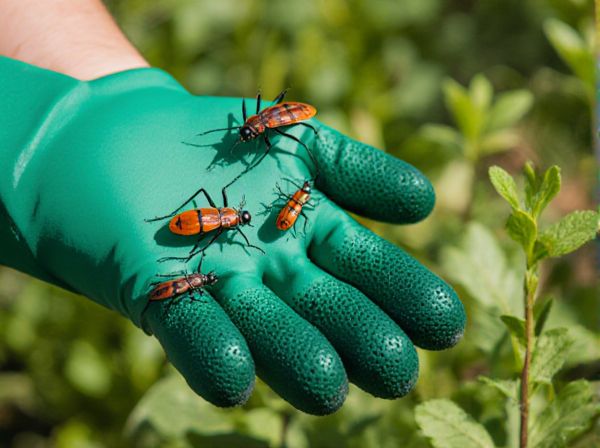
Beneficial Insects vs Pollinator Attractors Illustration
Beneficial insects play a crucial role in controlling pest populations by preying on harmful bugs, improving plant health and crop yields. Pollinator attractors, such as flowering companion plants, draw bees, butterflies, and other pollinators that enhance fruit and seed production through effective pollination. Combining beneficial insects with pollinator attractors creates a balanced ecosystem that supports both pest management and increased plant productivity.
Table of Comparison
| Feature | Beneficial Insects | Pollinator Attractors |
|---|---|---|
| Primary Role | Pest control by preying on harmful insects | Draw pollinators like bees and butterflies |
| Examples | Lacewings, Ladybugs, Parasitic Wasps | Lavender, Sunflowers, Bee Balm |
| Impact on Garden | Reduces pest populations naturally | Boosts pollination and fruit set |
| Best Use | Integrated Pest Management (IPM) | Enhancing flowering plant pollination |
| Attracts | Predatory and parasitic insects | Bees, Butterflies, Hummingbirds |
Understanding Beneficial Insects and Pollinator Attractors
Beneficial insects, such as ladybugs, lacewings, and parasitic wasps, play a crucial role in pest control by naturally reducing harmful insect populations in gardens and agricultural settings. Pollinator attractors, including flowering plants like lavender, sunflowers, and milkweed, enhance the presence of bees, butterflies, and other pollinators essential for plant reproduction and crop yield. Recognizing the distinct functions of beneficial insects and pollinator attractors helps optimize ecosystem health and promote sustainable gardening practices.
Key Differences Between Beneficial Insects and Pollinators
Beneficial insects encompass a variety of species that control pests, improve soil health, and support plant growth, while pollinator attractors specifically target the enhancement of pollination activities by drawing in pollinators like bees and butterflies. Key differences lie in their primary functions: beneficial insects include predators and parasitoids that reduce pest populations, whereas pollinator attractors focus solely on increasing pollination efficiency. Understanding these roles helps optimize garden ecosystems by balancing pest management with pollination support.
Types of Beneficial Insects in the Garden
Beneficial insects in the garden include ladybugs, lacewings, and parasitic wasps, which prey on common pests like aphids and caterpillars, promoting natural pest control. Predatory beetles and hoverflies help maintain plant health by reducing harmful insect populations, while ground beetles aid in soil aeration and nutrient cycling. Unlike general pollinator attractors, these insects contribute to ecosystem balance by targeting specific pest species, supporting both plant vitality and biodiversity.
Essential Pollinator Attractors for Healthy Gardens
Essential pollinator attractors such as lavender, borage, and sunflowers play a crucial role in maintaining healthy garden ecosystems by supporting beneficial insect populations. These plants provide vital nectar and pollen resources that enhance the activity of bees, butterflies, and hoverflies, which are key pollinators for fruit and vegetable crops. Incorporating essential pollinator attractors into garden companion planting strategies significantly improves plant health, yield, and biodiversity.
Roles Beneficial Insects Play in Pest Management
Beneficial insects such as ladybugs, lacewings, and parasitic wasps play crucial roles in natural pest management by preying on harmful pests like aphids, mites, and caterpillars, reducing the need for chemical pesticides. These predators enhance crop health and yield by maintaining balanced ecosystems, preventing pest outbreaks, and promoting sustainable agriculture. Unlike pollinator attractors that primarily support pollination, beneficial insects directly control pest populations, providing an essential service in integrated pest management strategies.
Enhancing Pollination Through Attractor Plants
Pollinator attractors, such as sunflowers and lavender, play a crucial role in enhancing pollination by drawing bees, butterflies, and other beneficial insects into the garden ecosystem. Unlike beneficial insects that prey on pests, pollinator attractors increase flower visitation rates, directly boosting fruit and seed production. Integrating these plants strategically improves biodiversity and supports sustainable crop yields by ensuring a consistent presence of pollinating agents.
Top Plants for Supporting Beneficial Insects
Top plants for supporting beneficial insects include native flowering species such as milkweed, goldenrod, and coneflower, which provide essential nectar and pollen resources. Herbs like dill, fennel, and yarrow attract predatory insects that naturally control garden pests. Incorporating these plants into companion planting strategies enhances ecosystem balance and improves pollinator presence.
Creating a Welcoming Habitat for Pollinators
Beneficial insects, including ladybugs and lacewings, help control pests naturally, creating a balanced ecosystem that supports pollinator populations. Pollinator attractors like native flowering plants and herbs provide essential nectar and pollen sources, encouraging bees, butterflies, and other pollinators to visit and thrive. Designing a garden with diverse, nectar-rich plants and protective habitats fosters a welcoming environment crucial for sustaining pollinator health and enhancing crop yields.
Balancing Pest Control and Pollination in the Garden
Beneficial insects such as ladybugs and predatory wasps play a crucial role in naturally controlling pest populations without harming pollinators like bees and butterflies. Pollinator attractors, including flowering plants like lavender and clover, enhance pollination by drawing in essential pollinators while also supporting beneficial insects. Balancing these elements optimizes garden health by maintaining pest control and promoting effective pollination for higher plant productivity.
Best Practices for Encouraging Both Beneficial Insects and Pollinators
Integrating diverse flowering plants throughout the garden creates habitat and sustenance for both beneficial insects like ladybugs and predatory wasps, as well as pollinators such as bees and butterflies. Avoiding broad-spectrum pesticides and providing continuous bloom periods from spring to fall supports the life cycles of these essential species. Planting native species and maintaining natural ground cover fosters shelter and breeding sites, optimizing the presence of pollinator attractors and beneficial insect populations concurrently.
Beneficial Insects vs Pollinator Attractors Infographic

 gardendif.com
gardendif.com